
It’s in the Air is a 1938 British comedy film written and directed by Anthony Kimmins and starring George Formby, Polly Ward and Jack Hobbs. The film was released in the United States with the alternative title George Takes the Air in 1940. The film depicts Great Britain's preparations for war with Air Raid Warden training, mock air attacks dropping poison gas bombs, and the deployment of anti-aircraft weapons in the streets.

David Willock was an American character actor. He appeared in 181 films and television series from 1939 to 1979.

Junior G-Men of the Air is a 1942 Universal film serial starring the Dead End Kids and the Little Tough Guys. A group of youthful flying enthusiasts join the "Junior G-Men" to help break up a planned attack on the United States.

Ceiling Zero is a 1936 American adventure drama film directed by Howard Hawks and starring James Cagney and Pat O'Brien. The picture stars Cagney as daredevil womanizing pilot "Dizzy" Davis and O'Brien as Jake Lee, his war veteran buddy and the operations manager of an airline company. Based on a stage play of the same name, the film blends drama with some light comedy. The title, as defined at the beginning of the picture, is an insider term referring to those moments when the sky is so thick with fog that navigating an aircraft is nearly impossible.

Danger Flight is a 1939 American film directed by Howard Bretherton and starring John Trent as Tailspin Tommy Tompkins, Marjorie Reynolds, Milburn Stone and Jason Robards Sr. The film featured young aviation enthusiasts in a model club.
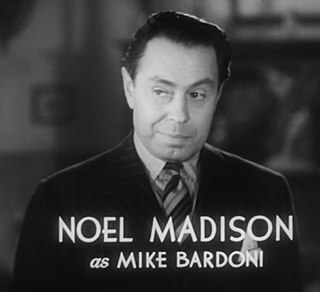
Noel Madison was an American character actor in the 1930s and 1940s and appeared in 75 films, often as a gangster.

Spies of the Air is a 1939 British adventure film directed by David MacDonald and based on the play Official Secret by Jeffrey Dell. The film stars Barry K. Barnes, Roger Livesey, Basil Radford, Edward Ashley and Felix Aylmer. Spies of the Air involves espionage in the period just before the outbreak of war in Europe that spawned a number of similar propaganda films linking aeronautics and spies. Films in both Great Britain and the United States centred on "... spies and fifth columnists (as) the staple diet of films made during the first year of the war."

The Skywayman was a 1920 American silent action drama film directed by James P. Hogan and produced and distributed by Fox Film Corporation. The film starred noted aerial stunt pilot Ormer Locklear and Louise Lovely. After having appeared in The Great Air Robbery (1919), a film that showcased his aerial talents, Locklear, considered the foremost "aviation stunt man in the world", was reluctant to return to the air show circuit. During the production, Locklear and his co-pilot Milton "Skeets" Elliot died after crashing during a night scene. The Skywayman was subsequently released shortly after, capitalizing on their deaths.
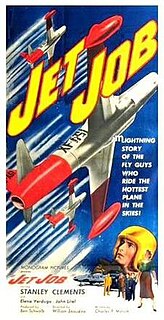
Jet Job is a 1952 American aviation action film directed by William Beaudine. The film stars Stanley Clements, John Litel and Bob Nichols. Jet Job features stock footage of various types of USAF military aircraft.

Murder in the Air is a 1940 American drama film with science fiction elements directed by Lewis Seiler and written by Raymond L. Schrock. The film stars Ronald Reagan, John Litel, Lya Lys, James Stephenson, Eddie Foy, Jr., Robert Warwick and Victor Zimmerman. Murder in the Air was released by Warner Bros. on June 1, 1940.

Blazing Sixes is a 1937 American Western film directed by Noel M. Smith and written by John T. Neville. The film stars Dick Foran, Joan Valerie, Mira McKinney, John Merton, Glenn Strange and Kenneth Harlan. It was the 9th of 12 B-westerns Foran starred in for the studio, and is noteworthy for giving perennial villain Strange a rare good-guy role as the simple-minded cowhand Pee Wee. The film was released by Warner Bros. on June 12, 1937.

The Fighting Pilot is a 1935 American action film directed by Noel M. Smith and starring Richard Talmadge, Gertrude Messinger and Robert Frazer. When an inventor develops a new type of aircraft, a crooked businessman attempts to steals the aircraft and its blueprints. The company test pilot, who is the boyfriend of the inventor's daughter, foil the criminals.

Pirates of the Skies is a 1939 American action film directed by Joseph A. McDonough and written by Lester Cole and Ben Grauman Kohn. The film stars Kent Taylor, Rochelle Hudson, Regis Toomey, Marion Martin, Samuel S. Hinds, Ray Walker and Lucien Littlefield. Pirates of the Skies was released on February 3, 1939, by Universal Pictures.
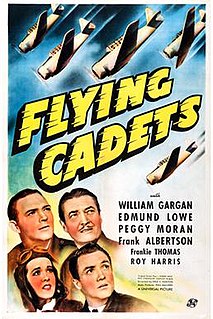
Flying Cadets is a 1941 American adventure film directed by Erle C. Kenton and written by George Waggner, Roy Chanslor and Stanley Rubin. The film stars William Gargan, Edmund Lowe, Peggy Moran, Frank Albertson, Frankie Thomas and Riley Hill. Flying Cadets was released on October 24, 1941, by Universal Pictures.
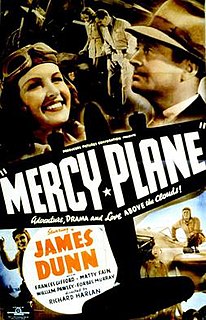
Mercy Plane is a 1939 American aviation crime drama film directed by Richard Harlan and starring James Dunn, Frances Gifford, William Pawley, and Matty Fain. The plot involves military aircraft being stolen by "hot plane" thieves, to be re-sold to new owners, with most of the world at war, presumably to war-torn countries. With location filming done at Alhambra Airport, California, the film features numerous aircraft models, including the Lockheed Model 12 Electra Junior as the "Mercy Plane". Lead actor Dunn, a licensed pilot, did his own flying in the film.

Pirates of the Sky is a 1926 American silent adventure melodrama film directed by Charles Andrews. The film stars Charles Hutchison, Wanda Hawley and Crauford Kent. In different sources, Pirates of the Sky distributed by Pathé Exchange has conflicting release dates of February 20, 1926 and March 21, 1927.
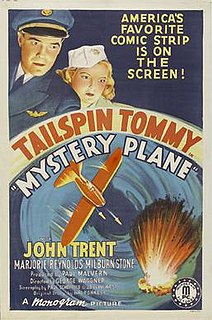
Mystery Plane is a 1939 American action film directed by George Waggner and written by Paul Schofield and George Waggner. The film is based on the comic strip Tailspin Tommy by Hal Forrest and Glenn Chaffin. The film stars John Trent, Marjorie Reynolds, Milburn Stone, Jason Robards Sr., George Lynn and Lucien Littlefield. Mystery Plane, the first of four "Tailspin Tommy" films made by Monogram Pictures, was released on March 8, 1939.

Stunt Pilot is a 1939 American adventure film directed by George Waggner and written by Scott Darling and George Waggner. The film is based on the comic strip Tailspin Tommy by Hal Forrest and Glenn Chaffin. Stunt Pilot stars John Trent, Marjorie Reynolds, Milburn Stone, Jason Robards Sr., Pat O'Malley and George Meeker. Following the success of Mystery Plane (1939), Stunt Pilot, the second in the "Tailspin Tommy" series, was released on July 2, 1939, by Monogram Pictures.
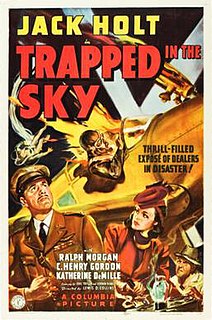
Trapped in the Sky is a 1939 American thriller film directed by Lewis D. Collins and produced by Larry Darmour for Columbia Pictures. The film stars Jack Holt, Ralph Morgan and Katherine DeMille.Holt is the "flyboy" who is trying to find the saboteurs of a "silent" aircraft. The plot device of a "noiseless" or stealthy aircraft is a familiar theme in aviation films of the period, including The Sky Ranger (1921), The Silent Flier (1926) and Eagle of the Night (1928).

Monrovia Airport, also called the Foothill Flying Field, was an American airport in Monrovia, California active from 1928 to 1952.




















